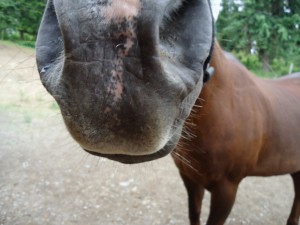 Did you know that in Switzerland and Germany their governments have banned the clipping of horses whiskers? Here’s why:
Did you know that in Switzerland and Germany their governments have banned the clipping of horses whiskers? Here’s why:
A horse’s muzzle is soft, and velvet-like. Personally, it’s one of my favorite places to pet on our quarter horses Pegasus and Sugar Babe. But that pettable muzzle isn’t why clipping a horse’s whiskers is a bad idea.
In the midst of the marshmallow-soft skin are scattered, course hairs, called vibrissae, or tactile hairs. These whiskers are a result of millions of years of evolution to help horses sense their environment.
Cutting those hairs can lead to injuries as a result of horses failing to avoid obstacles near their faces. Because horse’s eyes are set on the side of their heads. they have a blind spot in front of and right under their noses. So, their whiskers act as a sort of “third eye” helping them to negotiate objects close to their noses, such as food, water and the ground, avoiding injury and making sure they don’t eat the wrong thing.
For example we sometimes have some small rocks in the alfalfa hay we feed, and when the horses are done eating every single leaf of hay is gone, but the rocks remain.
Now that you know why some European countries have banned whisker clipping, do you think it should happen here, too?
Photo: The soft muzzle of our gelding, Pegasus

